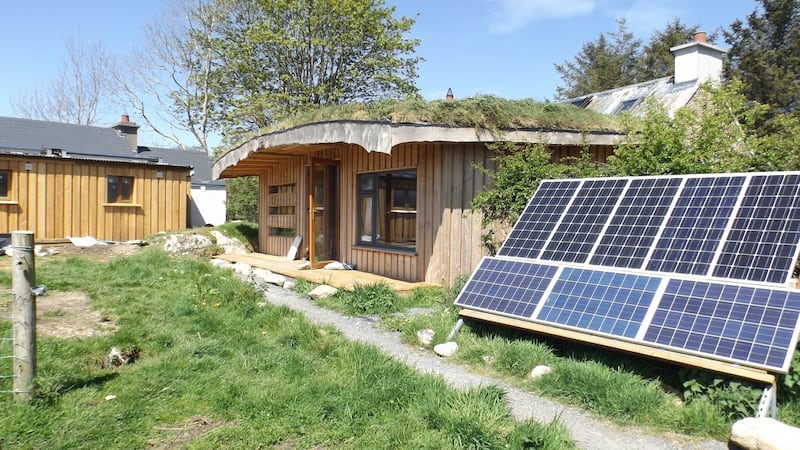Off-grid living, once the preserve of conspiracy theorists, megalomaniacal Bond villains and Charles Haughey on Inishvickillane, is becoming increasingly affordable and practical thanks to the latest generation of wind turbines, photovoltaic panels and batteries.
In a country where 20 per cent of households had no access to power in 1965 (the year the Beatles released Help), it can seem odd to now romanticise the notion of cutting the cable. Rural electrification brought such dramatic benefits that there is understandably less appetite in Ireland than elsewhere to abandon the national grid; yet the idea of liberating yourself from the cellophane-windowed envelopes of utility companies is encouraging an increasing number of people to generate their own electricity. So, what's it like?
Judith Hoad (78) has been living off-grid for 45 years, first in Wales and then, since 1981, on the side of a Donegal mountain.


A herbalist and teacher of acupressure and plant-collecting, she moved with her husband, artist Jeremiah Hoad, to a thatched cottage without running water.
“When our children were small the neighbours used to say, ‘Oh, pity for the children,’ because we had no television or electricity, but from the autumn equinox to the spring equinox we used to sit around and read aloud before bed every evening. We read all the Laura Ingalls Wilder books and used to sing and play music.”
Hoad has a 1kw wind turbine, with five 200 watt photovoltaic (PVs) panels and eight 12v batteries, although a tradesmen damaged the invertor 18 months ago and she been unable to fix it. She relies now on candles and a miner’s lamp.
“I don’t want to be on the grid. Electrical ring circuits are a cause for a great deal of disharmony, physically. I am an extraordinarily healthy beast. There are very few people of my age that have absolutely nothing wrong with them constitutionally, except a touch of arthritis.”
She uses rainwater butts for washing and fills flagons from a roadside well in Frosses for her drinking water. For those interested in experiencing this simpler way of life, she offers retreats in her timber and cob roundhouse.
On the opposite side of Ulster is Lackan Cottage Farm, a six-acre smallholding in the Mourne Mountains, which is part experiment and part demonstration model for an organic, permaculture homestead.
Steve Golemboski-Byrne abandoned his sensible career as production manager at the Newry Democrat to embark upon a more pioneering path for the sake of his young daughter.
“I genuinely believe that life will not be as easy for her generation as it has been for ours. A lot of this is finding solutions that she might benefit from.”
They have 4.5kw of PV arrays and a 3.5kw wind turbine, both are second-hand, but still fully efficient. They produce enough power for the whole site and a surplus which, from September, will power Northern Ireland’s only off-grid self-catering accommodation in a retrofitted old cottage.
Golemboski-Byrne highlights the importance of being able to fix your own electrical equipment. If anything goes wrong "we cannot pick up the phone and call NIE (Northern Ireland Electricity). I am responsible for making sure it stays on. When our solar hot water gets too hot it relies on me knowing how to fix it."
A key goal for Lackan Cottage Farm is to share the discoveries they make about a more self-sustaining lifestyle with others. They run permaculture courses and are always keen to advise others in their attempts to shift towards alternative heating and electrical solutions.
Likewise, a mission to make off-grid achievable for more people characterises the work of Jimmy Dowds and Miriam Sheerin of Offgrid.ie. Their company, Eirbyte, trains people to make domestic wind turbines and they also sell solar electric panels, hydropower turbines and deep-cycle batteries.
A secondary business offers web-hosting powered by renewable energy systems. Living off-grid has been something that Sheerin has wanted to do since watching Grizzly Adams as a child on television.
She characterises it as a fun adventure: “You look at the weather and decide, we’re not going to use the halogen oven today, maybe we’ll cook on the stove instead. If the sun is shining we’ll get out the electric grill or the induction hob, or put on a couple of washes. We don’t do without, but we do consider how and when we use our power.
“When we started out people didn’t believe that PVs would work in Ireland. In fact the Irish solar energy association told us that PVs definitely wouldn’t work here. People now see that solar electricity works and prices have come down hugely.”
How feasible is it to live off-grid? "Perfectly, if you are willing to be more mindful about your energy use: no half-hour electric showers at 20kw. A lot of people around here in Leitrim are off-grid. They are quiet about it; the neighbours mightn't even realise. Those who are interested solely from a financial point of view don't tend to stick with it, mostly it requires a keen interest in reducing one's carbon footprint."
Sheerin would like to see more local authorities and rural development boards offering build your own wind turbine courses for communities.
“Over the six- day course people learn so much more than just about building a turbine. It encourages independence and resilience. And if anything goes wrong you know how to dismantle your turbine and service it. You also have buddies from the course to help you.”
When Quentin Gargan of Construction PV began selling off-grid equipment in 2008 solar cost €8 per watt, it is now eight times cheaper. There has been a boom in the market with "builders being dragged kicking and screaming into using solar panels to meet Part L compliance of the building code".
His own home is a grass-roofed straw-bale building outside Bantry powered by wind turbines, photovoltaic panels and a micro-hydro. He built the first electric car in recent times in Ireland in 1991, based on a Mini Metro chassis, then bought an electric Citroën Berlingo van, and, since 2012, has been driving a Citroën C Zero.
“The technology improves massively every year or two,” but he’s not convinced about using electric vehicles for long journeys as it requires tapping into daytime electricity for recharging, which is less efficient that low-demand night electricity that is more often generated from wind.
“Eventually long journeys will be done by public transport. I drive to Cork station and charge my car there.”
While Gargan recommends the benefits of generating your own power, he does not necessarily advise living off-grid. “Running your electricity in and out of batteries costs about 15 cents per kw hour, while the retail price of electricity from the grid is about 16 cents. It doesn’t make financial sense to install batteries if you can access the national grid. It is more sustainable for me to feed my excess solar and wind power into the grid so that someone else can use it to reduce their own carbon emissions.”
Gargan's house and power supply is the ultimate expression of self-sufficiency, but it is possible to achieve self-sufficiency on a more modest scale. Noel Higgins built a transportable off-grid home for €6,000 in an effort to escape debt and increase his personal freedom.
He downsized four years ago from a four-bedroom bungalow into a tiny wooden home on wheels built from salvaged timber and recycled materials, packed tightly with sheep’s wool insulation. He now teaches others to do the same at occasional courses run by Carraig Dúlra (dulra.org). He uses a basic 150watt of PV to charge a 12v battery which is adequate for lights and to keep his phone and laptop charged, but he is in the process of building a pedal-driven turbine which would charge a battery in the absence of sun.
While requiring physical exertion, this form of turbine is more easily transportable and dependable than one powered by wind. Higgins points out that while “solar is getting cheaper all the time, it can still work out expensive if you are getting someone else to install it. It’s far better to learn how to do it yourself as it usually needs a bit of tweaking and the back-up service isn’t always great.”
Higgins’ main passion is organic and biodynamic farming. He has parked his home on a few different farms where he grows vegetables for sale, while bartering a few hours work for use of the land. The ultimate plan is to farm off-grid, without fossil fuels, using only draft-animal power. He has trained two bullocks (which he acquired through barter) as oxen for ploughing and pulling.
The idea is to also use them for generating power through turntables and pumping devices and he is collecting old draft-animal tools and equipment.
It has never been more feasible to leave off-grid in Ireland, but whether one is actually ready for the necessary adaptations is hard to gauge. A few days at Hoad's retreat space, or Lackan Cottage self-catering accommodation, would offer a good taster, or you could rent the only fully off-grid property on Airbnb, Roland Purcell's old famine cottage on a remote stretch of Donegal coast (airbnb.ie/rooms/2269632).
Perhaps pack away some old Laura Ingalls Wilder books and a song book to while away the nights.










